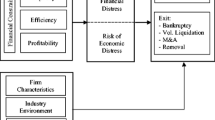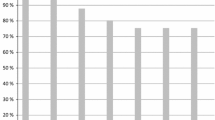Abstract
Firms may exit the market in several ways and each form of exit is likely to be caused by different factors (Schary in RAND J Econ 22:339–353, 1991). This paper explores the determinants of different exit routes. Using a sample of Spanish manufacturing firms for 1990–2000, we estimate a competing risks proportional hazards model to identify the factors leading firms to exit the market through (the mutually precluding events of) liquidation/bankruptcy and acquisition/merger. Our results show the existence of a sharp difference between the determinants of these two exit routes in terms of firm and industry characteristics.
Similar content being viewed by others
References
Agarwal R, Audretsch DB (2001) Does entry size matter? The impact of the life cycle and technology on firm survival. J Ind Econ 49: 21–43
Aldrich HE, Auster E (1986) Even dwarfs started small: liabilities of size and age and their strategic implications. Res Organ Behav 8: 165–198
Altman E (1968) Finan ratios, discriminant analysis, and the prediction of corporate bankruptcy. J Finance 23: 580–609
Audretsch DB (1995) Innovation, growth and survival. Int J Ind Organ 13: 441–457
Audretsch DB, Mahmood T (1995) New firm survival: new results using a hazard function. Rev Econ Stat 77: 97–103
Audretsch DB, Thurik R, Houweling P (2000) Firm survival in the Netherlands. Rev Ind Organ 11: 1–11
Bernard AB, Eaton J, Jensen JB, Kortum SS (2003) Plants and productivity in international trade. Am Econ Rev 93: 1268–1290
Bethel JE, Liebeskind JP, Opler T (1998) Block share purchases and corporate performance. J Finance 53: 605–634
Cleves MA, Gould WW, Gutierrez RG (2004) An Introduction to survival analysis using stata. Stata Corporation, College Station
Comanor WS, Wilson TA (1967) Advertising, market structure and performance. Rev Econ Stat 49: 423–440
Cox DR (1972) Regression models and life tables. J Roy Stat Soc 34: 187–220
Cox DR (1975) Partial likelihood. Biometrica 60: 269–276
Denis DJ, Sarin A (1989) Ownership and board structures in publicly traded Corporations. J Finan Econ 52: 187–223
Dickerson AP, Gibson HD, Tsakalotos E (1998) Takeover risk and dividend strategy: a study of UK firms. J Ind Econ 46: 281–300
Dickerson AP, Gibson HD, Tsakalotos E (2003) Is attack the best form of defence? A competing risks analysis of acquisition activity in the UK. Cambridge J Econ 27: 337–357
Disney R, Haskel J, Heden Y (2003) Entry, exit and establishment survival in UK manufacturing. J Ind Econ 51: 91–112
Doms M, Dunne T, Roberts MJ (1995) The role of technology use in the survival and growth of manufacturing plants. Int J Ind Organ 13: 523–545
Dunne T, Roberts MJ, Samuelson L (1988) Patterns of Firm Entry and Exit in US Manufacturing Industries. Rand J of Econ 19: 495–515
Efron B (1977) The efficiency of Cox’s likelihood function for censored data. J Am Stat Assoc 72: 557–565
Ericson R, Pakes A (1995) Markov-perfect industry dynamics: a framework for empirical work. Rev Econ Stud 62: 53–82
Esteve-Pérez S (2005) Exit with vertical product differentiation. Int J Ind Organ 23: 227–247
Esteve-Pérez S, Sanchis A, Sanchis JA (2004) The determinants of survival of Spanish manufacturing firms. Rev Ind Organ 25: 251–273
Esteve-Pérez S, Máñez JA (2008) The resource-based-view of the firm and firm survival. Small Bus Econ 30: 231–249
Fariñas J C, Moreno L (2000) Firms growth, size and age: a non-parametric approach. Rev Ind Organ 17: 249–265
Fichman M, Levinthal D (1991) Honeymoons and the liability of adolescence: a new perspective on duration dependence in social and organizational relationships. Acad Manage Rev 16: 442–468
Geroski P (1995) What do we know about entry?. Int J Ind Organ 13: 421–440
Gilbert L R, Menon K, Schwartz KB (1990) Predicting bankruptcy for firms in financial distress. J Bus Finan Acc 17: 161–171
Ghemawat P, Nalebuff B (1985) Exit. RAND J Econ 16: 184–194
Görg H, Strobl E (2003) Footlose Multinationals?. Manchester Sch 71: 1–19
Grambsch PM, Therneau T M (1994) Proportional Hazards Tests and Diagnostics based on Weighted Residuals. Biometrika 81: 515–526
Hannan M (1998) Rethinking age dependence in organizational mortality: logical formalizations. Am J Sociol 104: 126–164
Harhoff D, Stahl K, Woywode M (1998) Legal form, growth and exit of West German Firms. J Ind Econ 46: 453–488
Heiss F, Köke J (2004) Dynamics in ownership and firm survival: evidence from corporate Germany. Eur Finan Manage 10: 167–195
Honjo Y (2000) Business failure of new firms: An empirical analysis using multiplicative hazards model. Int J Ind Organ 18: 557–574
Jovanovic B (1982) Selection and the Evolution of Industry. Econometrica 50: 649–670
Kalbfleisch JD, Prentice RL (1980) The statistical analysis of failure time data. Wiley, New York
Kease K, McGuiness P (1990) The failure of UK industrial firms for the period 1976–84, logistic analysis and entropy measures. J Bus Finan Acc 17: 119–135
Kiefer NM (1988) Economic duration data and hazard functions. J Econ Lit 6: 646–670
Klepper S, Simons KL (2000) The making of an oligopoly: firm survival and technological change in the evolution of the US tire industry. J Pol Econ 108: 728–760
Köke J (2002) Determinants of acquisition and failure: evidence from corporate Germany. Struct Change Econ Dyn 13: 457–484
Lancaster T (1990) The econometric analysis of transition data. Cambridge University Press, Cambridge
Maksimovic V, Phillips G (2001) The market for corporate assets: who engages in mergers and asset sales and are there efficiency gains?. J Finance 56: 2019–2065
Mata J, Audretsch D (eds) (1995) The post-entry performance of firms. Int J Ind Organ 13:413–614 (special issue)
Mata J, Portugal P (1994) Life duration of new firms. J Ind Econ 42: 227–246
Mata J, Portugal P (2000) Closure and divesture by foreign entrants: the impact of entry and post-entry strategies. Strat Manage J 21: 549–562
Mata J, Portugal P (2002) The survival of new domestic and foreign-owned firms. Strat Manage J 23: 323–562
Mata J, Portugal P (2004) Patterns of entry, post-entry growth and survival: a comparison between domestic and foreign owned firms. Small Bus Econ 22: 283–298
Mata J, Portugal P, Guimaraes P (1995) The survival of new plants: start-up conditions and post-entry evolution. Int J Ind Organ 13: 459–481
Mulherin JH, Boone AL (2000) Comparing acquisitions and divestures. J Corp Finan 6: 117–131
Narendranathan W, Stewart MB (1991) Simple methods for testing the proportionality of cause-specific hazards in competing risks models. Oxford Bull Econ Stat 53: 331–340
Peel MJ, Wilson N (1989) The liquidation/merger alternative: some results for the UK corporate sector. Manage Dec Econ 10: 209–220
Scharfstein D (1988) The disciplinary role of takeovers. Rev Econ Stud 55: 185–199
Schary M (1991) The probability of exit. RAND J of Econ 22: 339–353
Segarra A (2002) La creación y la supervivencia de las empresas industriales. Civitas Ediciones, Madrid
Segarra A, Callejón M (2002) New firms survival and market turbulence: new evidence from Spain. Rev Ind Organ 20: 1–14
Shleifer A, Vishny RW (1992) Liquidation values and debt capacity: a market equilibrium approach. J Finance 47: 1343–66
Stiglitz J, Weiss A (1981) Credit rationing in markets with imperfect information. Am Econ Rev 71: 393–410
Stinchcombe F (1965) Social structure and organizations. In: March J (eds) Handbook of organizations. Rand McNally, Chicago, pp 142–193
Strotmann H (2007) Entrepreneurial survival. Small Bus Econ 28: 87–104
Sutton J (1991) Sunk costs and market structure. The M.I.T. Press, Cambridge
Wagner J (1994) The post-entry performance of new firms in German manufacturing industries. J Ind Econ 42: 141–154
Wernerfelt B (1984) A resource-based view of the firm. Strat Manage J 5: 171–180
Wheelock DC, Wilson PW (2000) Why do banks disappear? The determinants of U.S. bank failures and acquisitions. Rev Econ Stat 82: 127–138
Author information
Authors and Affiliations
Corresponding author
Rights and permissions
About this article
Cite this article
Esteve-Pérez, S., Sanchis-Llopis, A. & Sanchis-Llopis, J.A. A competing risks analysis of firms’ exit. Empir Econ 38, 281–304 (2010). https://doi.org/10.1007/s00181-009-0266-x
Received:
Accepted:
Published:
Issue Date:
DOI: https://doi.org/10.1007/s00181-009-0266-x




